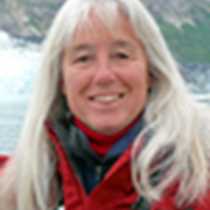Thomas Bay/Petersburg, Southeast Alaska
The morning was spent in Thomas Bay, on the mainland. Early morning fog lifted as we glided past the Baird Glacier and into Scenery Cove. Haunted tales about this bay added to the serene mystique that hovered around us. Red-billed loons and Arctic terns were fishing in the calm waters. During breakfast we anchored near Cascade Creek and went ashore for hikes. A short walk affords a view of the falls, with mist blowing by the sun’s rays streaming through the forest. Beyond the falls, steps rise steeply to a bench where the trail flattens out on its way to a hefty bridge that crosses the raging torrent. In a skunk cabbage bog, a brown and orange rough-skinned newt was found. This is a very toxic salamander and is best handled with gloves. Bushwhackers made their way through the underbrush to discover some ponds with lots of signs of moose. Others continued up the trail for some good exercise.
Petersburg was founded on Mitkof Island by Norwegian people in 1898. They brought with them their homeland heritage of fishing and fish processing. Today, the traditions continue at Tonka Seafoods, Inc., where owners Shari Otness and Wendel Gilbert hosted a group from the Sea Bird. They specialize in wholesale and retail all-natural custom processing. We had an introduction to the five eastern Pacific salmon species and then toured their facility, which includes forced air smokers, a vacuum packer, and a retort pressure canner. In the above photograph, salmon has been readied for smoking, after having been filleted and soaked in a mixture of sugared brine. The smoke from alder, maple and birch is infused into the fish during the smoking procedure, which takes a total of about twelve hours and includes smoking (seven hours at about 70 degrees F.), cooking (to 150 degrees F. internal temperature for pasteurization) and cooling (about two hours). Samples for tasting were offered after the tour.
We also heard a present-day perspective on the life of local fishing families when Becky Knight came on board before our departure from Petersburg. For over twenty years she and her husband have commercially fished the Alaskan waters – mostly for salmon and halibut – bringing up their two sons in the process. She discussed some of the trials and tribulations of the industry and stressed the importance of consuming wild Pacific salmon (as opposed to farmed salmon). Becky expressed mixed feelings about the likelihood that her sons will continue in their parent’s footsteps. For the young people aboard the Sea Bird it was an opportunity to learn about how other families live and work together.
The morning was spent in Thomas Bay, on the mainland. Early morning fog lifted as we glided past the Baird Glacier and into Scenery Cove. Haunted tales about this bay added to the serene mystique that hovered around us. Red-billed loons and Arctic terns were fishing in the calm waters. During breakfast we anchored near Cascade Creek and went ashore for hikes. A short walk affords a view of the falls, with mist blowing by the sun’s rays streaming through the forest. Beyond the falls, steps rise steeply to a bench where the trail flattens out on its way to a hefty bridge that crosses the raging torrent. In a skunk cabbage bog, a brown and orange rough-skinned newt was found. This is a very toxic salamander and is best handled with gloves. Bushwhackers made their way through the underbrush to discover some ponds with lots of signs of moose. Others continued up the trail for some good exercise.
Petersburg was founded on Mitkof Island by Norwegian people in 1898. They brought with them their homeland heritage of fishing and fish processing. Today, the traditions continue at Tonka Seafoods, Inc., where owners Shari Otness and Wendel Gilbert hosted a group from the Sea Bird. They specialize in wholesale and retail all-natural custom processing. We had an introduction to the five eastern Pacific salmon species and then toured their facility, which includes forced air smokers, a vacuum packer, and a retort pressure canner. In the above photograph, salmon has been readied for smoking, after having been filleted and soaked in a mixture of sugared brine. The smoke from alder, maple and birch is infused into the fish during the smoking procedure, which takes a total of about twelve hours and includes smoking (seven hours at about 70 degrees F.), cooking (to 150 degrees F. internal temperature for pasteurization) and cooling (about two hours). Samples for tasting were offered after the tour.
We also heard a present-day perspective on the life of local fishing families when Becky Knight came on board before our departure from Petersburg. For over twenty years she and her husband have commercially fished the Alaskan waters – mostly for salmon and halibut – bringing up their two sons in the process. She discussed some of the trials and tribulations of the industry and stressed the importance of consuming wild Pacific salmon (as opposed to farmed salmon). Becky expressed mixed feelings about the likelihood that her sons will continue in their parent’s footsteps. For the young people aboard the Sea Bird it was an opportunity to learn about how other families live and work together.




